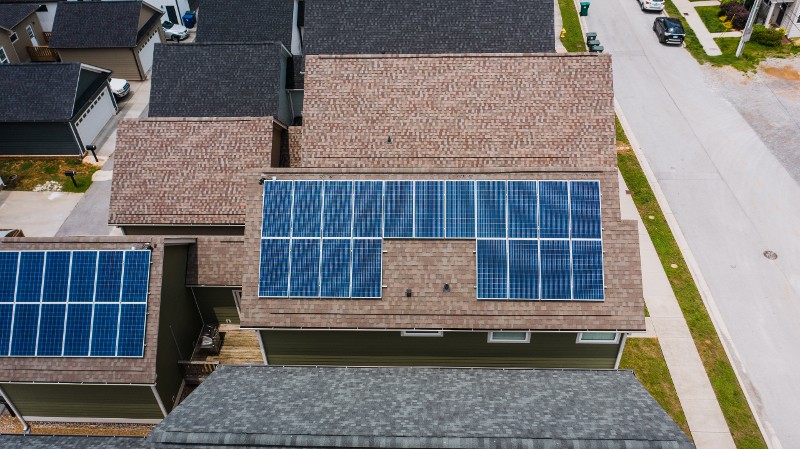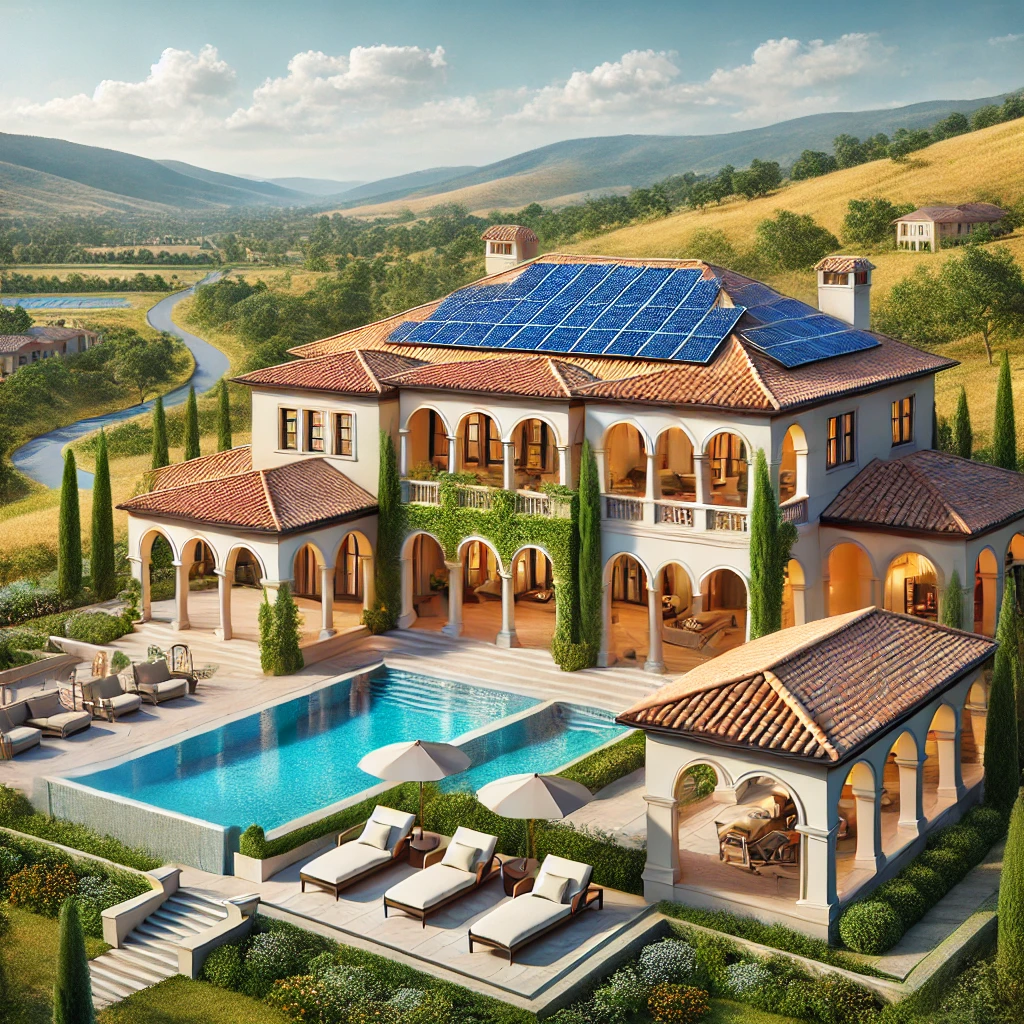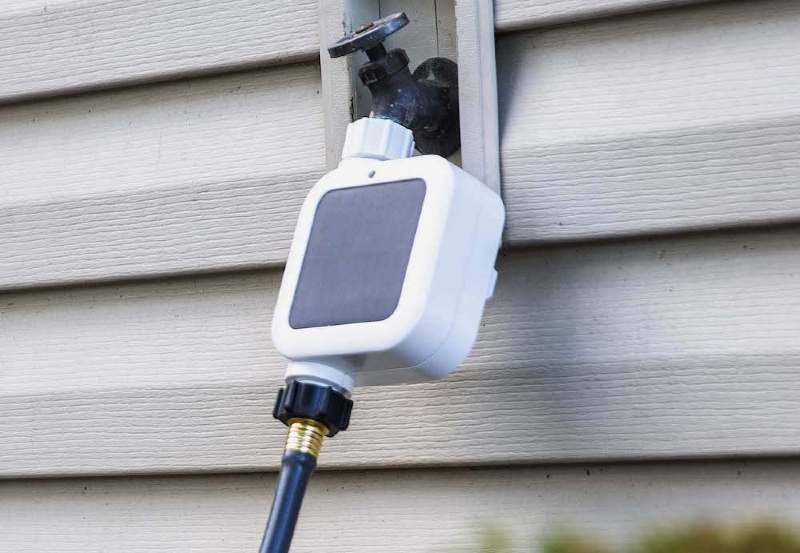There are so many solar-powered irrigation timers and controllers out there, each claiming to make your gardening a breeze.
It can be pretty overwhelming trying to figure out which one will work best for you, right?
To make things easier, I’ve tested more than 35 models and picked out the best ones that stand out in terms of performance, reliability, and efficiency.
In this article, I’m going to break down the features, benefits, and downsides of each top device.
This way, you’ll have all the info you need to choose the right one for your garden’s specific watering needs.
The Best Solar Powered Irrigation Timers & Controllers Selection
Editor’s Choice: Gardena 13300-20 AquaBloom Irrigation Timer & Controller
Features
- Material: Plastic
- Irrigation Type: Drip irrigation
- Dimensions: 19.69 x 23.62 x 3.94 inches
The Gardena AquaBloom is our top pick for a good reason.
It can water up to 20 plants automatically and evenly, making gardening so much easier.
I tested it in my garden, which has a mix of roses, hydrangeas, tomatoes, and herbs.
With 14 preset watering programs, I could customize how often and how much water each plant gets.
For example, my tomatoes need frequent, deep watering, while my roses prefer less frequent but thorough watering.
One feature that sets the AquaBloom apart is its flexibility.
I’ve redesigned my garden several times, and adjusting the device setup was a breeze.
When I expanded my herb garden, I easily extended the drip irrigation system to cover the new plants.
The high-quality micro-drip components also ensure even water distribution, no matter how I rearrange my garden.
However, I did notice one minor issue: the plastic threads on the connectors can wear out over time, especially with frequent adjustments or harsh weather conditions.
Despite this, the Gardena AquaBloom is highly recommended for its flexibility, automation, and ease of use.
What We Like
- Automatic and even watering for up to 20 plants
- 14 pre-set watering programs for customization
- High-quality micro-drip components for even water distribution
- Ready-to-use set for easy installation
What We Don’t Like
- Potential wear and tear on plastic threads of connectors
Runner up: DIG ECO1ILV.075 Solar Powered Irrigation Time & Controller
Features
- Irrigation Type: Drip irrigation or sprinkler system
- Dimensions: 6 x 4 x 5 inches
The DIG ECO1ILV.075 works great with both drip irrigation and sprinkler systems, making it super adaptable.
I put this timer to the test in my garden, which has both systems.
First, I used it with my drip irrigation system, which waters my vegetables and flowering plants at specific intervals.
The DIG timer handled it perfectly, giving reliable and accurate watering schedules.
A few months later, I added a sprinkler system for my lawn and some larger plants.
Switching the timer to work with the new system was easy – I just reprogrammed it, and it adapted seamlessly.
Another thing I love about the DIG ECO1ILV.075 is its 6 x 4 x 5 inches, so it doesn’t take up much space.
I installed it near the hose connection, and it blends in nicely without being an eyesore.
However, the interface could be better.
The settings are tricky to navigate, and there’s no clear “back” button, which can be frustrating.
Also, the inlet and outlet sizes are different.
One side is a 3/4″ universal hose thread, and the other is a 3/4″ universal pipe thread, so I had to make an extra trip to the hardware store for fittings.
Despite these small issues, the DIG ECO1ILV.075 works reliably once set up, providing consistent and efficient watering for my garden.
What We Like
- Works with drip and sprinkler systems
- Compact and easy to install
- Precise watering schedule settings
What We Don’t Like
- Confusing user interface
- Inlet and outlet sizes are different
Best Bang for the Buck: Ancnoble GG-005C-1 Irrigation Timer
I know that sometimes we just need a smart solution for our garden without breaking the bank.
That’s where the Ancnoble GG-005C-1 Irrigation Timer & Controller shines.
This model features a unique motion sensor-based irrigation system that detects plant movements, like the wind blowing, to decide when and how much to water.
I saw it in action on a breezy afternoon.
As the wind made the plants sway more, the device increased the watering.
This smart feature keeps plants hydrated, even when the wind speeds up evaporation.
I also love the clear, anti-glare screen that shows the watering schedule and system status, making it easy to adjust settings without squinting or finding shade.
One drawback is the solar panel setup.
It doesn’t come with a mounting bracket, so you’ll need to find a way to attach it securely.
The panel cord could also be longer for more flexibility in positioning.
Additionally, it doesn’t show if the solar panel is charging the batteries, which can be a bit of a guessing game.
Overall, despite these minor issues, the Ancnoble GG-005C-1 offers a smart, cost-effective solution for your garden.
What We Like
- Motion sensor-based irrigation system
- Easy customization of schedules and settings
- The anti-glare screen even in bright sunlight
- Sleek and compact design
What We Don’t Like
- No assembly bracket for the solar panel.
- Short built-in panel cord.
- No charging indicator for the solar panel.
Best Solar Smart Hose: Netro Pixie Smart Irrigation Timer
The Netro Pixie features a smart hose irrigation system that delivers water directly to your plants’ roots.
This precise watering minimizes runoff and ensures your plants get exactly what they need.
When I set it up in my flower bed with delicate plants, I saw firsthand how efficiently the water was directed to each plant’s root zone, preventing overwatering and potential damage.
One of the standout features of the Netro Pixie is its weather forecasting capability.
This feature adjusts the watering schedule based on the upcoming weather, ensuring your garden gets the right amount of water regardless of the forecast.
For instance, during a week of heavy rain, the device automatically reduced the watering frequency, protecting my plants from being overwatered.
You can also connect this model to your home WiFi which adds a layer of convenience.
With a simple tap on your smartphone, you can initiate watering sessions even if you’re not physically near the controller.
One drawback is the plastic material used in the construction of this controller.
While it is lightweight and durable, I noticed that the plastic housing could be prone to scratches and scuffs over time.
Despite this minor concern, the Netro Pixie’s precise watering, automatic weather adjustments, easy setup, and durable design make it a standout option for integrating smart home technology into your gardening routine.
What We Like
- Precise and targeted watering
- Adaptability to weather conditions through weather forecasting
- Hassle-free installation with direct WiFi 2.4G connection
- A UV-resistant and waterproof design
What We Don’t Like
- The plastic construction is prone to scratches and scuffs
What Are Solar Irrigation Timers?
Solar irrigation timers are devices used in irrigation systems that use solar energy to measure and control the time and duration of watering.
They are usually integrated into a sprinkler system or drip irrigation setup.
These devices help reduce water waste and promote efficient water use, which benefits both the environment and the gardener’s or farmer’s water bills.
How Do Solar Irrigation Timers Work?
Solar irrigation timers work by harnessing the energy from the sun and converting it into electricity to power their operations.
Their operation can be broadly categorized into three main parts: solar energy collection, storage, and irrigation control.
The primary component of a solar irrigation timer is the solar panel which collects solar energy based on the photovoltaic effect.
When the sunlight hits the solar panel’s surface, the energy from the sun triggers the movement of electrons in the semi-conductive material within the panel.
This motion of electrons results in an electric current.
After solar energy collection, we move to energy storage’s second crucial stage.
The electric current generated by the solar panel doesn’t go to waste; it is utilized to charge a rechargeable battery within the timer.
This battery serves as a reservoir for the harvested solar energy.
As a result, the device can sustain its operations even during periods without sunlight, such as at night or on cloudy days.
The third and most vital function comes into play – irrigation control.
The irrigation timer uses the energy stored in the battery to automate the irrigation process based on user-defined parameters.
You can input your desired watering times and durations through a simple interface.
Some advanced models even allow for zone-specific scheduling within a garden or field, further enhancing their utility and water conservation effectiveness.
Moreover, many modern solar irrigation timers incorporate smart technology features, bridging the gap between green energy and high-tech functionality.
For instance, some models can connect with moisture sensors embedded in the ground.
These sensors relay real-time data on soil moisture levels to the timer.
When these levels drop below a user-defined threshold, the timer activates the irrigation system, ensuring that plants receive water exactly when needed.
Finally, during an irrigation cycle, the timer sends a signal to the irrigation valves, prompting them to open. Water then begins to flow through the system.
Upon reaching the user-set watering duration, the timer signals to close the valves, halting the water flow.
How to Choose the Best Solar Irrigation Timers?
1. Irrigation Type
When choosing the best solar irrigation timer, your irrigation type is the first factor to consider.
There are several irrigation methods, each with unique needs that your timer should accommodate.
For instance, if your garden uses a sprinkler system, the solar irrigation timer you choose should be equipped to manage the high water flow rates typical of this system.
Sprinkler systems distribute a large amount of water over a broad area in a short period, similar to rainfall.
This makes them ideal for watering lawns or large garden beds such as our pick DIG ECO1ILV.075 Solar Powered Irrigation Timer & Controller.
However, your needs will differ if you use a drip irrigation system in your garden.
Drip irrigation systems deliver water slowly and directly to the root zones of plants.
This makes them excellent for vegetable plots, flower beds, or other plantings that benefit from targeted watering.
A timer like the Gardena 13300-20 AquaBloom Irrigation Timer & Controller would be a good fit for these types of systems.
This is why I’ve included various examples of timers suited to different irrigation systems, so you can select the one that aligns with your gardening and irrigation needs.
2. Flexible Timer & Controlling Function
Flexibility refers to the ability of the timer to adapt to various watering schedules, allowing you to customize when and how much water your plants receive.
A flexible timer is crucial if you have a diverse range of plants, each with unique watering needs.
The controlling function refers to how the timer is managed and operated.
Traditional timers require manual operation, meaning you’ll have to adjust the device’s settings physically.
This can be time-consuming and not always convenient, especially if the timer is in a hard-to-reach area.
On the other hand, modern solar irrigation timers often come with advanced features such as WiFi connectivity or Bluetooth compatibility, allowing you to operate and adjust the device remotely.
This means you can manage your watering schedules conveniently from your smartphone or tablet.
A good example of such a timer would be the Netro Pixie Solar-Powered Irrigation Timer and Controller, which can be controlled remotely via its mobile app.
3. Material & Quality
The material of the timer determines its durability and ability to withstand different weather conditions.
Solar-powered irrigation timers must be robust and weather-resistant due to frequent exposure to various outdoor conditions.
Typically, the best timers are those made of high-quality materials like metal.
Metal timers can withstand extreme temperatures and are less susceptible to accidental bumps or impact damage.
While plastic models might not have the same level of durability as their metal counterparts, they have certain advantages.
One of the key advantages of plastic timers is their lightweight nature. This makes them easier to handle during installation and allows for more flexibility in positioning.
Plastic timers are also typically more affordable than metal timers, making them a budget-friendly option for many gardeners.
Another benefit is that plastic timers are less susceptible to corrosion than metal timers.
This can be advantageous in areas with high humidity or saltwater environments, where corrosion can be a significant concern.
I’ve tested each model on this list, and I can assure you that all of them are made of quality materials that won’t break during installation or shipping.
FAQs
Can Solar-Powered Irrigation Timers Work in Areas With Limited Sunlight?
Solar-powered irrigation timers can work in areas with limited sunlight, but their functionality may be compromised.
Do Solar-Powered Irrigation Timers Require Professional Installation?
Solar-powered irrigation timers generally do not require professional installation, as they are designed for easy setup and can be installed by homeowners with basic knowledge of irrigation systems.
Can I Control the Irrigation System Remotely Through a Smartphone App?
You can control the irrigation system remotely through a smartphone app if the solar-powered irrigation timer model offers this feature.
Conclusion
As promised, we’ve covered the 4 best solar-powered irrigation timers and controllers available in the market.
Each device offers unique features and advantages to meet your specific gardening needs.
And I’d highly recommend the Gardena AquaBloom Irrigation Timer & Controller.
Its customizable watering programs and easy installation simplify the irrigation process and ensure your plants receive the right amount of water.
Do you still have any questions?
Feel free to leave them in the comments below.
Join our solar microdosing newsletter and get bite-sized, easy-to-understand insights into the world of solar energy.
From how solar panels work to building your own DIY solar system, we’ve got you covered.








